Students
Here are some profiles about the students in the 2022 cohort, and their projects…
Mahandry Andrianarimisa is a PhD student in Conservation Biology at the University of Antananarivo. His project will focus on host-parasite specificity of frog-biting midges in the Corethrellidae family and the impact of light and noise pollution inside natural habitats on that parasitism system in Madagascar. This will be the first detailed study on the Corethrellidae family (biting midges) in Madagascar. It would also serve as a guide to protected area managers on the acceptable level of sounds and light pollution in ecotourism spots. Mahandry holds a Master’s degree in Conservation Biology from University of Antananarivo, during which he developed techniques for sampling these frog-biting midges. He also holds a Bachelor’s degree in organismal and ecosystems biology from the University of Antananarivo. Mahandry enjoys cultural exchanges, travel and discovery, singing and playing guitar, wildlife documentaries, comedies and action movies.
Angelo Andrianiaina is a PhD student in the Department of Zoology and Animal Biodiversity at the University of Antananarivo. His project will focus on the seasonal dynamics of Bartonella in Malagasy fruit bat ectoparasites. Angelo hopes this information will aid in the comprehensive understanding of Malagasy fruit bat population health and corresponding conservation efforts. Angelo holds a Master’s Zoology and Animal Biodiversity as well as a Bachelor’s in Animal Biology, Ecology,and Conservation from University of Antananarivo. Angelo is also the Communication Officer and Co-founder of the conservation biologists Association Ary Saina and an active member of GERP (Groupe d’Etude et de la Recherche sur les Primates de Madagascar).
 Zo Samuel Ella Fenosoa is a PhD Student in biological and environmental science at the University of Antananarivo. Her project focuses on mistletoe (Bakerella spp.) fruit removal by frugivores and the germination of mistletoe seeds in Ranomafana National Park. This work will help elucidate the mutualistic interactions between mistletoe and seed-dispersing frugivores. She received her Master’s and Bachelor’s degrees in Biological Sciences from University of Antananarivo. In the past, Fenosoa has collaborated with scientists at Rice University and GERP (Groupe d’étude et de recherche sur les primates de Madagascar).
Zo Samuel Ella Fenosoa is a PhD Student in biological and environmental science at the University of Antananarivo. Her project focuses on mistletoe (Bakerella spp.) fruit removal by frugivores and the germination of mistletoe seeds in Ranomafana National Park. This work will help elucidate the mutualistic interactions between mistletoe and seed-dispersing frugivores. She received her Master’s and Bachelor’s degrees in Biological Sciences from University of Antananarivo. In the past, Fenosoa has collaborated with scientists at Rice University and GERP (Groupe d’étude et de recherche sur les primates de Madagascar).
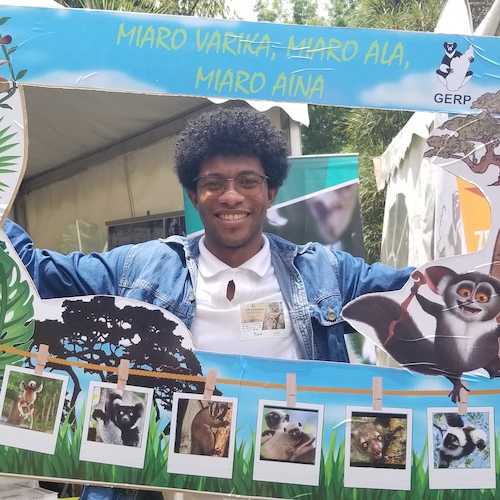 Ginot Kava is a Master’s student in Animal Conservation Biology at the University of Antananarivo. His project will focus on lemur density and ecological preference of 3 lemur species in Ambohidray. His data include the DBH perches of lemurs, perch heights, plant species richness, canopy openness and more based on line-transect sampling. This work will help guide the conservation policies of the newly protected area at Ambohidray, especially aiding in lemur conservation. Ginot’s other interests include S.C.O.U.T., benevola, basketball and dance.
Ginot Kava is a Master’s student in Animal Conservation Biology at the University of Antananarivo. His project will focus on lemur density and ecological preference of 3 lemur species in Ambohidray. His data include the DBH perches of lemurs, perch heights, plant species richness, canopy openness and more based on line-transect sampling. This work will help guide the conservation policies of the newly protected area at Ambohidray, especially aiding in lemur conservation. Ginot’s other interests include S.C.O.U.T., benevola, basketball and dance.
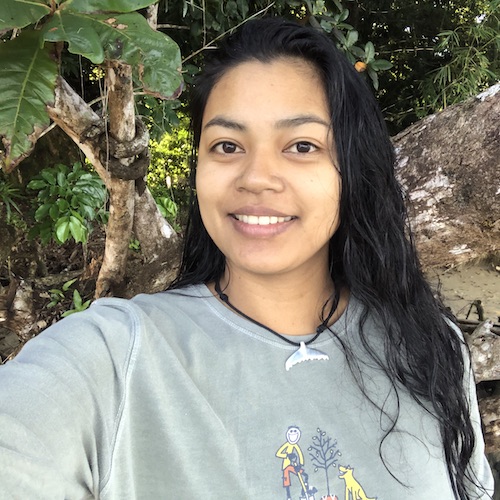 Miary Raselimanana is an Adjunct lecturer in the Zoology and Animal Biodiversity Department at the University of Antananarivo. Her research project aims to understand the interspecific variation and sex-specific variation in perch use in two threatened and short-lived chameleons: Furcifer labordi and Furcifer nicosiai in Kirindy, Morondava. Miary hopes her work documenting microhabitat preference and niche partitioning among sympatric chameleon species will help guide habitat management. Miary earned her Master’s degree in Animal Biology, Ecology and Conservation from the University of Antananarivo. Her Master's thesis focused on the habitat use and population structure of chameleons in the dry forest of Kirindy, Morondava. She also earned a Bachelor of Science in Organismic Biology and Ecosystem Ecology University of Antananarivo. Miary can also be found volunteering for Ikala STEM, Teach For Madagascar and Club Vintsy Aloe Vera.
Miary Raselimanana is an Adjunct lecturer in the Zoology and Animal Biodiversity Department at the University of Antananarivo. Her research project aims to understand the interspecific variation and sex-specific variation in perch use in two threatened and short-lived chameleons: Furcifer labordi and Furcifer nicosiai in Kirindy, Morondava. Miary hopes her work documenting microhabitat preference and niche partitioning among sympatric chameleon species will help guide habitat management. Miary earned her Master’s degree in Animal Biology, Ecology and Conservation from the University of Antananarivo. Her Master's thesis focused on the habitat use and population structure of chameleons in the dry forest of Kirindy, Morondava. She also earned a Bachelor of Science in Organismic Biology and Ecosystem Ecology University of Antananarivo. Miary can also be found volunteering for Ikala STEM, Teach For Madagascar and Club Vintsy Aloe Vera.
 Rindra Harilanto Nantenaina is a PhD student in Plant Biology and Ecology at the University of Antananarivo. Her project will document the importance of plant galls in the diet of the Black-and-white ruffed lemur (Varecia variegata), characterize the role of galls in attracting lemur frugivores, and determine the influence of galls on the eventual seed dispersal of the infested trees. This project will advance scientific knowledge on the ecology of galls as well as lemur seed dispersal ecology. Rindra also holds a Master’s degree in Diagnostics, Ecological Monitoring and Ecosystem Management as well as a Bachelor’s in Plant Biology from University of Antananarivo. She has also served as a mentor at E2M2, an Ecological and Epidemiological Modeling course taught in Ranomafana, Madagascar.
Rindra Harilanto Nantenaina is a PhD student in Plant Biology and Ecology at the University of Antananarivo. Her project will document the importance of plant galls in the diet of the Black-and-white ruffed lemur (Varecia variegata), characterize the role of galls in attracting lemur frugivores, and determine the influence of galls on the eventual seed dispersal of the infested trees. This project will advance scientific knowledge on the ecology of galls as well as lemur seed dispersal ecology. Rindra also holds a Master’s degree in Diagnostics, Ecological Monitoring and Ecosystem Management as well as a Bachelor’s in Plant Biology from University of Antananarivo. She has also served as a mentor at E2M2, an Ecological and Epidemiological Modeling course taught in Ranomafana, Madagascar.
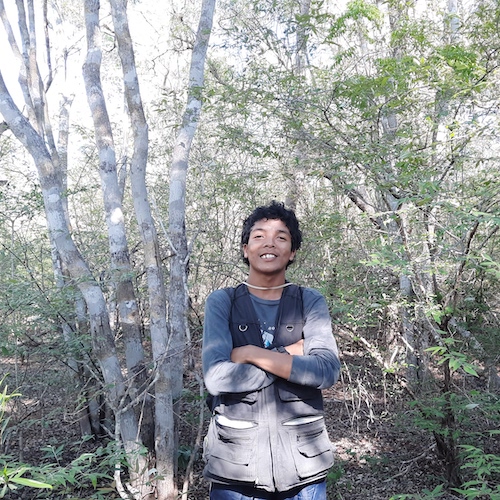 Tanjoniaina Hery Nirina Patrick Rabarijaonina is a Master’s student in Zoology and Animal Biodiversity at the University of Antananarivo. His project will explore the potential role of rodents in the secondary dispersal of an orphaned baobab species in Madagascar’s tropical dry forest. This study will help guide the conservation efforts and habitat restoration for baobabs with much needed information about animal seed dispersal. Tanjona earned his Bachelor’s degree in Life and Earth Sciences from the University of Antananarivo. His other pastimes include playing football, volleyball, petanque, chess and video games as well as cooking, playing guitar, farming, traveling and reading.
Tanjoniaina Hery Nirina Patrick Rabarijaonina is a Master’s student in Zoology and Animal Biodiversity at the University of Antananarivo. His project will explore the potential role of rodents in the secondary dispersal of an orphaned baobab species in Madagascar’s tropical dry forest. This study will help guide the conservation efforts and habitat restoration for baobabs with much needed information about animal seed dispersal. Tanjona earned his Bachelor’s degree in Life and Earth Sciences from the University of Antananarivo. His other pastimes include playing football, volleyball, petanque, chess and video games as well as cooking, playing guitar, farming, traveling and reading.
Nirintsoa Raharinomena is a Master’s student in Diagnosis, Ecological Monitoring and Design of Terrestrial Ecosystems in the Department of Plant Biology and Ecology at the University of Antananarivo. Her project concerns the impact of megafauna loss on seed dispersal and seedling establishment of Malagasy baobab trees. This work intends to advise conservation and restoration work to consider the seed dispersal process to the benefit of both animal seed-dispersers and plant species such as the iconic Malagasy baobab tree. Nirintsoa is also an intern with the ARO-Baobab Project (PEER USAID) and a member of two student associations: FAMMI Moramanga and FMSA Ankatso Antananarivo. Nirintsoa’s other pastimes include travel, reading, football and film documentaries.
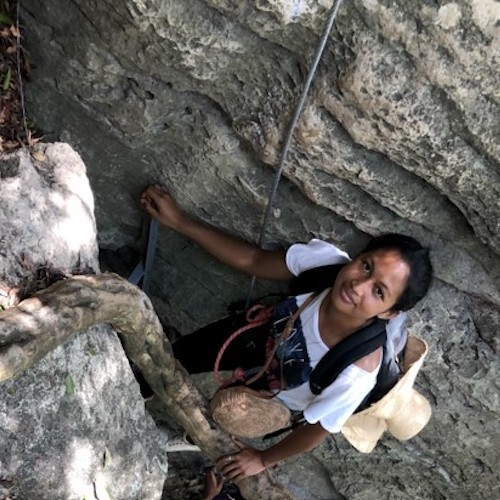 Mikoja Rambinintsoa is a research assistant with ESSA at the University of Antananarivo. Her project focuses on biodiversity conservation and climate change in the Bezà Mahafaly Special Reserve, in Southwestern Madagascar. This study will conclude with a proposal for conservation strategies in the face of climate variability to ensure the preservation of the unique biodiversity heritage of the Bezà Mahafaly Special Reserve. Mikoja earned her Master’s degree in Forestry and Environmental sciences and Bachelor’s degree in Agronomy and Environmental Sciences from the University of Antananarivo. She is a member of the Society for Conservation Biology (SCB) and wants to contribute concretely to the development of conservation activities in Madagascar.
Mikoja Rambinintsoa is a research assistant with ESSA at the University of Antananarivo. Her project focuses on biodiversity conservation and climate change in the Bezà Mahafaly Special Reserve, in Southwestern Madagascar. This study will conclude with a proposal for conservation strategies in the face of climate variability to ensure the preservation of the unique biodiversity heritage of the Bezà Mahafaly Special Reserve. Mikoja earned her Master’s degree in Forestry and Environmental sciences and Bachelor’s degree in Agronomy and Environmental Sciences from the University of Antananarivo. She is a member of the Society for Conservation Biology (SCB) and wants to contribute concretely to the development of conservation activities in Madagascar.
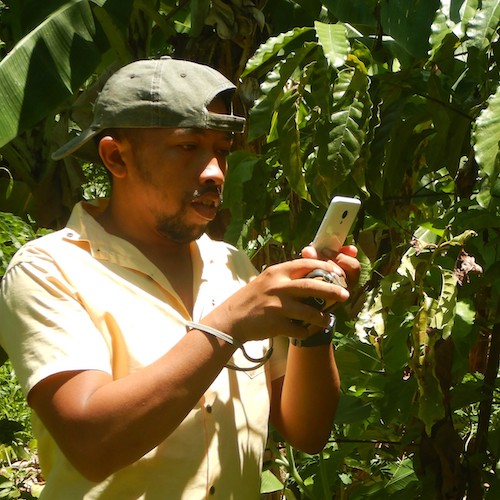 Tonisoa Tabihamalala Ranaivoandriamanantena is a PhD student in Life Sciences and the Environment at the University of Antananarivo. Tonsioa’s project focuses on the reintroduction of two of Madagascar’s most threatened baobab species: Adansonia perrieri and Adansonia suarezensis. This study aims to evaluate baobab trait variations related to fruits, seeds and seedlings in order to aid future species improvement, restoration and conservation. Tonisoa holds a Master’s in Plant Biology from the University of Antananarivo and is also a project manager for Madagasikara Voakajy. He is also a National Geographic grant recipient for his project “Fruits characteristics and seeds quality production of Adansonia perrieri and Adansonia suarezensis baobabs”.
Tonisoa Tabihamalala Ranaivoandriamanantena is a PhD student in Life Sciences and the Environment at the University of Antananarivo. Tonsioa’s project focuses on the reintroduction of two of Madagascar’s most threatened baobab species: Adansonia perrieri and Adansonia suarezensis. This study aims to evaluate baobab trait variations related to fruits, seeds and seedlings in order to aid future species improvement, restoration and conservation. Tonisoa holds a Master’s in Plant Biology from the University of Antananarivo and is also a project manager for Madagasikara Voakajy. He is also a National Geographic grant recipient for his project “Fruits characteristics and seeds quality production of Adansonia perrieri and Adansonia suarezensis baobabs”.
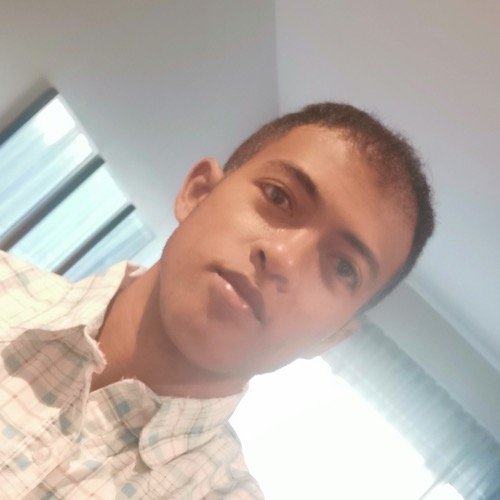 Tsiry Hasina Randriambolamanantsoa is a PhD candidate in the Virology Unit at Institut Pasteur of Madagascar. His project will investigate Respiratory Syncytial Virus (RSV) dynamics in Madagascar. RSV is the leading cause of acute respiratory infections (ARI) in children ≤5 years old in Madagascar and this study hopes to understand the factors that determine the repetitive circulation dynamic, source of introduction, and pattern of spread of the virus across the country. Tsiry received one Master’s in Trade and Marketing Intelligence at the University of Technology and Business, Antananarivo and another Master’s in Applied Biochemistry at the Malaria research Unit and Immunology Unit at IPM, in conjunction with the University of Antananarivo. He also holds a Bachelor’s degree in Biochemistry from the University of Antananarivo. His other interests include volleyball, basketball and event organization.
Tsiry Hasina Randriambolamanantsoa is a PhD candidate in the Virology Unit at Institut Pasteur of Madagascar. His project will investigate Respiratory Syncytial Virus (RSV) dynamics in Madagascar. RSV is the leading cause of acute respiratory infections (ARI) in children ≤5 years old in Madagascar and this study hopes to understand the factors that determine the repetitive circulation dynamic, source of introduction, and pattern of spread of the virus across the country. Tsiry received one Master’s in Trade and Marketing Intelligence at the University of Technology and Business, Antananarivo and another Master’s in Applied Biochemistry at the Malaria research Unit and Immunology Unit at IPM, in conjunction with the University of Antananarivo. He also holds a Bachelor’s degree in Biochemistry from the University of Antananarivo. His other interests include volleyball, basketball and event organization.
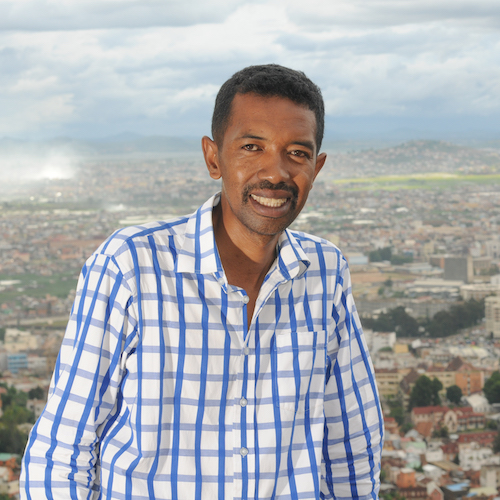 Andrianarivelosoa Solohery Rasamison is a PhD Student in Animal Biology at the University of Antananarivo. His project will examine acoustic sampling and long-term monitoring of bird populations in Mariarano in order to estimate the avifauna density and demography of the area. This will be the first demography study of forest birds in the Mariarano dry forest. Solohery earned his master’s degree in Biology, Ecology and Animal Conservation from University of Antananarivo. His Master’s thesis focuses on the breeding biology of Foudia omissa and Foudia madagascariensis at Ranomafana National Park. He has also served as a freelance birding tour guide for Madagascar Expedition Travel Agency.
Andrianarivelosoa Solohery Rasamison is a PhD Student in Animal Biology at the University of Antananarivo. His project will examine acoustic sampling and long-term monitoring of bird populations in Mariarano in order to estimate the avifauna density and demography of the area. This will be the first demography study of forest birds in the Mariarano dry forest. Solohery earned his master’s degree in Biology, Ecology and Animal Conservation from University of Antananarivo. His Master’s thesis focuses on the breeding biology of Foudia omissa and Foudia madagascariensis at Ranomafana National Park. He has also served as a freelance birding tour guide for Madagascar Expedition Travel Agency.
 Fanohinjanaharinirina Rasoamalala a current PhD student in the Plague Unit of Institut Pasteur de Madagascar. Her project is titled “Implication of small mammal fleas in the epidemiology of plague in Ankazobe.” She will be analyzing the role of fleas in the dynamics and transmission of plague (Yersinia pestis) from the Ankazobe district. This study will highlight the fluctuation of the flea population in an endemic focus and propose a better control and surveillance strategy in Madagascar. Fanohinjanaharinirina received her Master’s degree in Biochemistry, Biodiversity and Health from the University of Antananarivo during which time she studied the molecular detection of Yersinia pestis and Rickettsia sp. in mammalian ectoparasites. Fanohinjanaharinirina has earned two B.S. degrees: one in biochemistry and molecular biology from the University of Antananarivo and another in biomedical technics from ACEEM University.
Fanohinjanaharinirina Rasoamalala a current PhD student in the Plague Unit of Institut Pasteur de Madagascar. Her project is titled “Implication of small mammal fleas in the epidemiology of plague in Ankazobe.” She will be analyzing the role of fleas in the dynamics and transmission of plague (Yersinia pestis) from the Ankazobe district. This study will highlight the fluctuation of the flea population in an endemic focus and propose a better control and surveillance strategy in Madagascar. Fanohinjanaharinirina received her Master’s degree in Biochemistry, Biodiversity and Health from the University of Antananarivo during which time she studied the molecular detection of Yersinia pestis and Rickettsia sp. in mammalian ectoparasites. Fanohinjanaharinirina has earned two B.S. degrees: one in biochemistry and molecular biology from the University of Antananarivo and another in biomedical technics from ACEEM University.
Rojo Nandrianina Ravelojaona is a PhD candidate in the Department of Zoology and Biodiversity of Animals at the University of Antananarivo. Rojo will be studying land use change and lemur health in Ambohidray. This study will help guide the conservation strategy used in this newly protected area. Rojo earned his Master’s in Zoology and Animal Biology studying bats in Mandrozo. He also has a Bachelor’s in Animal Biology from the University of Antananarivo. He has previously worked with the conservation group Madagascar Voakajy and outside of work he is involved in the Scout Movement, Asity Madagascar and OpenStreetMap Madagascar (OSM).
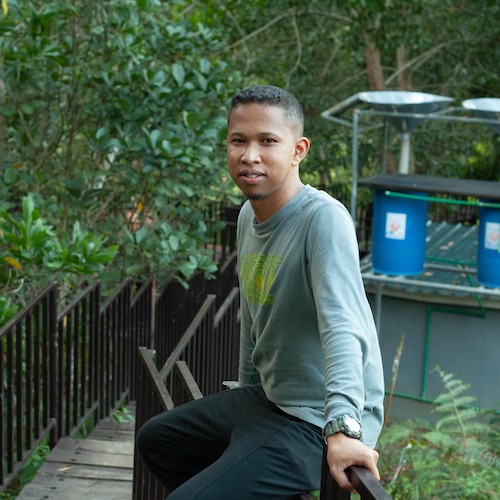 Faranky Ravelomandrato is a Ph.D. Candidate in Biology, Ecology and Animal Conservation at the University of Antananarivo. His project will focus on mother-infant relationships of the Aye-aye (Daubentonia madagascariensis) in the classified forest of Kianjavato in order to understand the bonds and all social aspects of the mother-infant social unit. Faranky holds a Master’s degree in Animal Conservation Biology from the University of Antananarivo for their work on nocturnal lemur densities and ecology of Lepilemur aeeclis in Antrema, Madagascar. Outside of science, Faranky’s hobbies include photography, traveling, reading, and music.
Faranky Ravelomandrato is a Ph.D. Candidate in Biology, Ecology and Animal Conservation at the University of Antananarivo. His project will focus on mother-infant relationships of the Aye-aye (Daubentonia madagascariensis) in the classified forest of Kianjavato in order to understand the bonds and all social aspects of the mother-infant social unit. Faranky holds a Master’s degree in Animal Conservation Biology from the University of Antananarivo for their work on nocturnal lemur densities and ecology of Lepilemur aeeclis in Antrema, Madagascar. Outside of science, Faranky’s hobbies include photography, traveling, reading, and music.
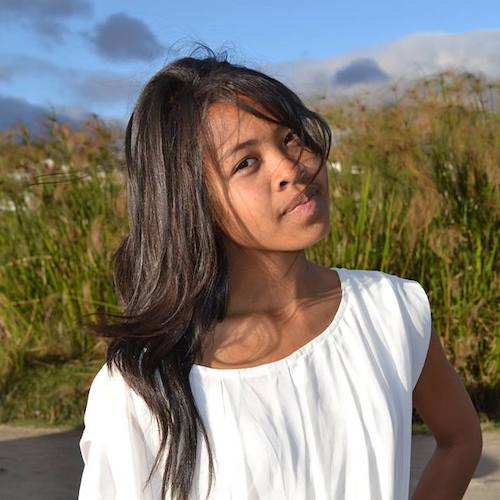 Onimalala Annick Raveloson is currently a laboratory technician and PhD student vector-borne diseases in the Medical Entomology Unit at Institut Pasteur de Madagascar. Her project is titled “The role of the human flea Pulex irritans and implication of insecticide resistance in plague transmission in Madagascar.” She is studying the plague vectorial capacity and insecticide resistance in the human flea (Pulex irristans). This work will allow health personnel to develop a more effective vector control strategy given the possibility that other flea species, apart from rat fleas (X. cheopis), may play a role in the epidemiology of plague in Madagascar. Onimalala holds a Master’s in Biochemistry, Biodiversity and Health from the University of Antananarivo during which she reviewed techniques for assessing the sensitivity of rat fleas Xenopsylla cheopis to insecticides. She earned her B.S. in Fundamental and Applied Biology from the University of Antananarivo. Outside of work, Onimalala is interested in reading, sports, and cinema.
Onimalala Annick Raveloson is currently a laboratory technician and PhD student vector-borne diseases in the Medical Entomology Unit at Institut Pasteur de Madagascar. Her project is titled “The role of the human flea Pulex irritans and implication of insecticide resistance in plague transmission in Madagascar.” She is studying the plague vectorial capacity and insecticide resistance in the human flea (Pulex irristans). This work will allow health personnel to develop a more effective vector control strategy given the possibility that other flea species, apart from rat fleas (X. cheopis), may play a role in the epidemiology of plague in Madagascar. Onimalala holds a Master’s in Biochemistry, Biodiversity and Health from the University of Antananarivo during which she reviewed techniques for assessing the sensitivity of rat fleas Xenopsylla cheopis to insecticides. She earned her B.S. in Fundamental and Applied Biology from the University of Antananarivo. Outside of work, Onimalala is interested in reading, sports, and cinema.